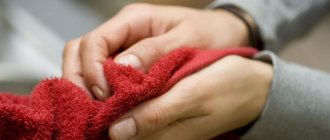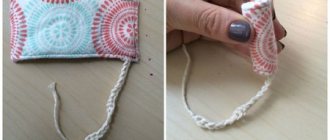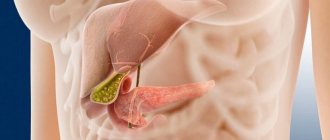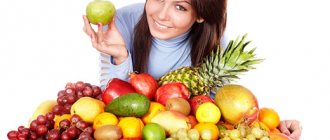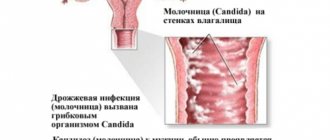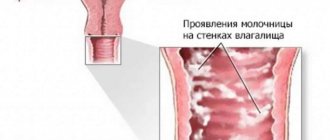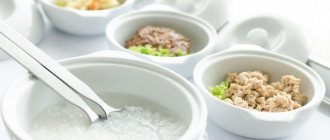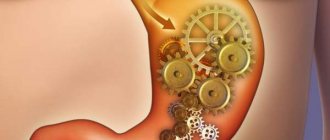General rules
Candida albicans fungi are saprophytic fungi and are present in small quantities in the oral cavity, gastrointestinal tract and vagina. Under certain conditions conducive to their reproduction, or when immunity , they exhibit pathogenic properties.
When exposed to certain medications, burns, or surgical operations, they can cause candidal pneumonia , stomatitis , or purulent diseases.
Depending on the location, three forms are distinguished. Superficial candidiasis - occurs with damage to the mucous membranes (mouth, esophagus, vagina or intestines). The second form is superficial invasive candidiasis without damage to organs and deep, which is characterized by damage to the parenchyma of organs.
The most common form is urogenital, the so-called thrush . It develops when the immune system is weakened or after antibiotic therapy. The triggering factors for the disease are pregnancy , menopause , wearing tight underwear, and the use of contraception.
In women, thrush appears with burning and itching of the genitals, cheesy discharge, and discomfort when urinating. In men - itching and burning of the glans penis and foreskin, the appearance of a white coating on them and pain when urinating.
When treating candidiasis of any localization, one dose of medication or local procedures is not enough. An integrated approach is required, which includes a healthy lifestyle and proper nutrition.
Diet for thrush in women
Nutrition is the main point in the treatment of this disease. Treatment will not be effective until simple carbohydrates, which promote the proliferation of yeast-like fungi, are excluded from the diet:
- sugar;
- powdered sugar;
- confectionery;
- honey;
- jam;
- Brown sugar;
- dried fruits;
- chocolate;
- glucose (in tablets and sugar substitutes);
- lactose (found in dairy products);
- fructose (sweet fruits, fruit juices, purees);
- starchy foods and vegetables (white rice, potatoes, cooked beets and carrots).
A diet excluding carbohydrates should be followed for at least three months, and preferably one year. Sugar-containing desserts should not be consumed even when there are no signs of illness.
You should also exclude:
- hot seasonings and sauces (horseradish, vinegar, mustard, mayonnaise, ketchup);
- products containing dyes, preservatives;
- yeast products: beer, kvass, bread and bakery products;
- concentrated broths rich in extractives;
- sweet carbonated drinks;
- limit the consumption of tea and coffee.
Separately, it is worth mentioning alcohol, which is not compatible with the treatment of the disease. Many patients experience a relapse of the disease after drinking alcohol.
List of diet products for thrush that must be included in the diet:
- Garlic has antibacterial and antifungal effects. Garlic extract completely stops the growth of fungi. Garlic should be constantly present in the diet, regardless of the stage of treatment.
- Green and onions should also be included fresh in the diet.
- Natural yogurt with active cultures and probiotic-rich foods. If it is difficult to find yogurt with live cultures or you doubt their presence in the product, learn how to make yogurt yourself from cultures sold in pharmacies. Regular consumption of these fermented milk products reduces the risk of thrush by 35-40%. It is the beneficial bacteria that prevent the growth of yeast.
- Include blueberries, sea buckthorn, lingonberries, cranberries and sour drinks made from them, which have an antibacterial effect, in your diet.
- Vegetables and unsweetened fruits (broccoli, beets, cucumbers, pumpkin, Brussels sprouts, carrots, green apples, plums, lemons).
- Seafood.
- Olive and linseed oil.
- Greens (parsley, dill).
- Lean meats, poultry and fish.
- Legumes.
- Cereals (buckwheat, brown rice) and wholemeal breads low in refined carbohydrates.
- Any nuts and seeds.
- Water (1.5 l), herbal anti-inflammatory teas from chamomile, plantain, burdock root, alfalfa, rose hips, oregano.
- Vitamin preparations that increase immunity.
- Probiotic preparations with lactobacilli (oral and local use).
This diet must be followed for three to four months during treatment, and for the purpose of prevention - twice a year for a month.
Diet for intestinal candidiasis
The first place in the frequency of gastrointestinal lesions is occupied by candidiasis. Risk factors are immunodeficiencies, cancer, AIDS, antibiotic therapy, organ transplantation, allergic diseases when treated with glucocorticosteroids .
Intestinal candidiasis occurs with signs of intoxication, the presence of unformed stools, flatulence , bloating, and cramping abdominal pain. The most important thing is that the symptoms do not disappear when the antibiotics and a normal diet is followed. Amphotericin B , Ketoconazole , Itraconazole , Fluconazole is effective .
Fruit and vegetable puree
heartburn , swallowing problems, and pain in the sternum when swallowing may occur The basic principles of nutrition for these localizations of the process remain the same, only they will take longer to implement. Damage to the esophagus limits the intake of rough foods (vegetables and fruits) due to pain. In this regard, it is recommended to consume boiled vegetables in the form of puree, fruits in the form of unsweetened jelly, pureed meat and porridge.
In the first days, when severe pain bothers you, mucous rice and oatmeal decoctions and raw eggs will help. All dishes should be at a gentle temperature so that they do not provoke increased pain. It is not advisable to consume milk during treatment.
The diet for intestinal candidiasis should include:
- Garlic and oregano (in the form of infusion).
- Consume 25-30 g of fiber daily - some from vegetables and fruits, and some from ground flax seeds. They are best taken with water between meals.
- Increase your intake of whole grains (brown rice, oatmeal - not cereal).
- Regularly consume fermented milk products with live cultures or take medications with live cultures (in capsule form) or prebiotics.
- Take B vitamins, which are necessary for the synthesis of digestive enzymes.
- Enter juices from wheat grass (other greens), which are rich in chlorophyll, which supports beneficial microflora.
To avoid relapse, you need to limit your sugar intake, avoid stress, and avoid taking antibiotics unnecessarily.
Oral candidiasis is the second most common fungal infection of the gastrointestinal tract. The main role in its development is played by weakened immunity . Its development is facilitated by treatment with antibiotics, steroids and antimetabolites, obesity , diabetes mellitus , in which impaired carbohydrate metabolism creates a favorable background.
Acute pseudomembranous candidiasis of the oral cavity is the most common. It often occurs in infants and has a benign course. In adults, it accompanies various diseases: neoplasms, diabetes mellitus , anemia , hypovitaminosis, or is an early sign of AIDS. The mucous membranes of the cheeks, palate, back of the tongue and lips are affected. Against the background of redness of the mucous membrane, a white coating is observed (like cottage cheese or curdled milk). At the beginning of the process, it is easily removed, but in severe cases, the plaque is more dense and difficult to remove, exposing the eroded surface. Patients complain of burning and pain in the mouth when eating.
Chronic atrophic candidiasis occurs in patients using removable dentures and is characterized by damage to the mucous membrane under them.
The diet for this localization of the process differs only in the method of preparing food: it should be liquid or puree. It is good to include liquid porridges (oatmeal, semolina, rice) and pureed soups.
Restrictions are also introduced on the consumption of sour fruits and berries, citrus fruits and tomatoes, the organic acids of which will irritate the oral mucosa. As your condition improves, your diet needs to be expanded.
For oral candidiasis, the following would be appropriate:
- dairy products;
- pureed cottage cheese diluted with kefir or yogurt;
- neutral fruits (watermelon, fresh apple puree);
- non-irritating vegetable juices (carrot and cabbage);
- ground meat and boiled minced fish, soufflés and pates;
- beaten raw egg, and subsequently - egg porridge;
- low-fat and not very salty broths.
In case of recurrent candidal stomatitis, it is necessary to carefully examine and establish their cause, and to prevent exacerbations, it is necessary to adhere to the generally accepted medical nutrition for this disease for a long time (6-8 months).
Candidiasis with skin lesions is often localized in the folds of the skin (axillary, groin), in the spaces between the toes, under the mammary glands, in the folds of the genitals. Red, swollen lesions with vesicles and erosions appear in the affected areas. One of the factors in the appearance of the disease is humidity, at which Candida rapidly develops and becomes pathogenic. Nutrition does not differ in any way from generally accepted recommendations.
Features of nutrition for candidiasis
Candidiasis most often occurs due to weakened immunity, but there are other reasons that can provoke it:
- Infection of a newborn during childbirth if the mother is sick. This also includes breastfeeding;
- Hormonal disorders;
- Frequent and severe stress;
- Long-term use of hormonal drugs;
- Frequent changes of partners, because the disease is sexually transmitted;
- Diabetes.
Symptoms of candidiasis depend on the affected area:
- Vagina: white cheesy discharge, itching, discomfort during sexual intercourse and urination;
- Oral cavity: painful white patches on the cheeks, tongue and gums;
- Male genital organs: burning, itching and pain, grayish coating;
- Gastrointestinal tract: decreased appetite, unpleasant taste in the mouth, increased body temperature, pain in the upper abdomen, vomiting with white films and blood.
Authorized Products
Thus, the list of foods for thrush includes low-fat protein foods (meat, fish, poultry), non-starchy vegetables, seasonings, herbs and nuts.
Main courses are prepared from lean meat (chicken, beef). It is better to boil or bake it. These can be cabbage rolls, stuffed zucchini, meat casseroles with vegetables. Low-fat fish is boiled or baked with sour cream sauce.
Broccoli, Brussels sprouts, cauliflower
Non-starchy vegetables are allowed, which can be boiled, stewed, or made into vegetable cutlets. Fresh vegetables are the most valuable. In stews you need to add spices and garlic. Non-starchy vegetables include eggplant, broccoli, Brussels sprouts, Chinese cabbage, watercress, cucumbers, spinach, sorrel, celery, tomatoes, and beet tops. Moderately starchy - turnips, carrots, zucchini. Zucchini, pumpkin, potatoes, beets, squash, Jerusalem artichokes, radishes and radishes contain a large amount of starch, so it is better to exclude them.
If you eat beets, carrots and pumpkin, it is better to eat them raw, as an addition to salads. These boiled or stewed vegetables increase the sugar content, which is not desirable for thrush. Avoid potatoes as they are a highly starchy product, and if you still decide to eat them, soak them before cooking to remove the starch. Try to add sprouted grains (barley, millet, wheat), which are immunostimulants, to salads. Sauerkraut populates the intestines with beneficial microorganisms, so it should be included in the diet.
You can use cereals as a side dish, but with restrictions, since these are sources of carbohydrates (albeit complex ones). Dairy products allowed: milk (with restrictions), natural yogurt and biokefir. In principle, all fermented milk products are useful for candidiasis, since lactic acid bacteria inhibit putrefaction and fermentation in the intestines and are natural antifungal drugs, but products with active bacteria are especially useful. Choose yoghurts from the baby food line (unsweetened, without preservatives and dyes) or prepare it yourself from live cultures. You can eat cottage cheese, as it also prevents the activity of pathogenic flora.
Replace regular bread with yeast-free bread; bake yeast-free bread from whole grain flour with bran, flax or sesame seeds.
Their drinks include a decoction of rose hips, decoctions of cranberries, lingonberries, fruit drinks made from these berries, decoctions and teas from herbs - plantain, oregano, chamomile, alfalfa. Green tea is allowed with restrictions.
Table of permitted products
| Proteins, g | Fats, g | Carbohydrates, g | Calories, kcal | |
Vegetables and greens | ||||
| spicy vegetables | 2,8 | 0,5 | 5,3 | 36 |
| vegetables legumes | 9,1 | 1,6 | 27,0 | 168 |
| cabbage | 1,8 | 0,1 | 4,7 | 27 |
| Brussels sprouts | 4,8 | 0,0 | 8,0 | 43 |
| sauerkraut | 1,8 | 0,1 | 4,4 | 19 |
| green onion | 1,3 | 0,0 | 4,6 | 19 |
| bulb onions | 1,4 | 0,0 | 10,4 | 41 |
| beet tops | 2,1 | 0,5 | 5,5 | 17 |
| celery | 0,9 | 0,1 | 2,1 | 12 |
| garlic | 6,5 | 0,5 | 29,9 | 143 |
| spinach | 2,9 | 0,3 | 2,0 | 22 |
| sorrel | 1,5 | 0,3 | 2,9 | 19 |
Fruits | ||||
| lemons | 0,9 | 0,1 | 3,0 | 16 |
| apples | 0,4 | 0,4 | 9,8 | 47 |
Berries | ||||
| cowberry | 0,7 | 0,5 | 9,6 | 43 |
| cranberry | 0,5 | 0,0 | 6,8 | 26 |
Cereals and porridges | ||||
| buckwheat (kernel) | 12,6 | 3,3 | 62,1 | 313 |
| oat groats | 12,3 | 6,1 | 59,5 | 342 |
| brown rice | 7,4 | 1,8 | 72,9 | 337 |
| brown rice | 6,3 | 4,4 | 65,1 | 331 |
Raw materials and seasonings | ||||
| carnation | 6,0 | 20,1 | 27,0 | 323 |
| cinnamon | 3,9 | 3,2 | 79,8 | 261 |
| Bay leaf | 7,6 | 8,4 | 48,7 | 313 |
Dairy | ||||
| acidophilus | 2,8 | 3,2 | 3,8 | 57 |
| yogurt | 4,3 | 2,0 | 6,2 | 60 |
Cheeses and cottage cheese | ||||
| cottage cheese | 17,2 | 5,0 | 1,8 | 121 |
Meat products | ||||
| beef | 18,9 | 19,4 | 0,0 | 187 |
| veal | 19,7 | 1,2 | 0,0 | 90 |
| rabbit | 21,0 | 8,0 | 0,0 | 156 |
Bird | ||||
| chicken | 16,0 | 14,0 | 0,0 | 190 |
| turkey | 19,2 | 0,7 | 0,0 | 84 |
Eggs | ||||
| chicken eggs | 12,7 | 10,9 | 0,7 | 157 |
Oils and fats | ||||
| peasant unsalted butter | 1,0 | 72,5 | 1,4 | 662 |
| corn oil | 0,0 | 99,9 | 0,0 | 899 |
| olive oil | 0,0 | 99,8 | 0,0 | 898 |
| sunflower oil | 0,0 | 99,9 | 0,0 | 899 |
Non-alcoholic drinks | ||||
| mineral water | 0,0 | 0,0 | 0,0 | — |
| lingonberry juice | 0,1 | 0,0 | 10,7 | 41 |
Juices and compotes | ||||
| carrot juice | 1,1 | 0,1 | 6,4 | 28 |
| tomato juice | 1,1 | 0,2 | 3,8 | 21 |
| pumpkin juice | 0,0 | 0,0 | 9,0 | 38 |
| * data is per 100 g of product | ||||
Trigger foods: what not to eat during treatment
The main thing that a diet for thrush is aimed at is creating a certain environment in the intestines that can resist the growth of yeast. Proper nutrition and normalization of the gastrointestinal tract will not only increase the population of beneficial microorganisms, but also improve immunity, which is especially important in the treatment of candidiasis.
Experts note that most often this disease and its recurrent forms are encountered by patients who abuse certain products. Despite the fact that the disease is quite common and a huge number of men and women are faced with it, many do not and can not eat with thrush.
The success of treatment will remain a big question if the patient, while taking medications and using ointments and suppositories, eats foods prohibited for thrush:
- sweets (chocolate, jam, candies);
- semi-finished products;
- potatoes (especially fried);
- baked goods (white bread, buns);
- alcohol;
- coffee;
- sauces (mayonnaise, ketchup).
If you have thrush, you should not eat all those foods that cause an increase in acidity - such an environment allows the fungus to progress and reduces the use of antifungal drugs to “no”. The list of foods not recommended for thrush also includes canned food, legumes, corn melon and watermelon.
Fully or partially limited products
Provides for the exclusion of all types of simple carbohydrates and products that contain fructose , galactose , sorbitol , maltose , glucose , monosaccharides , sucrose . If you cannot completely eliminate these components, then reduce their consumption to a minimum. For these reasons, you should not consume fruit juices and sweet fruits (pears, melons, grapes, dried fruits).
Products containing yeast are excluded: baked goods and beer. Mushrooms in any form are prohibited, as are cheeses (processed and blue cheeses). All foods and dishes that have an irritating effect should be excluded: hot seasonings, sauces (mayonnaise, ketchup), horseradish, vinegar, mustard, smoked, salted and pickled foods. Fatty pork, duck and goose meat, smoked meats, and canned food are excluded from meat products. Do not eat fried foods that promote the growth of yeast. Fatty fish, smoked fish and canned fish are also prohibited.
It is undesirable to use concentrated broths rich in extractive substances. Products with artificial colors and preservatives are not allowed in the diet. Strong coffee and tea, sweet juices, sweet carbonated water and alcohol should be excluded from drinks.
Table of prohibited products
| Proteins, g | Fats, g | Carbohydrates, g | Calories, kcal | |
Vegetables and greens | ||||
| canned vegetables | 1,5 | 0,2 | 5,5 | 30 |
| zucchini | 0,6 | 0,3 | 4,6 | 24 |
| potato | 2,0 | 0,4 | 18,1 | 80 |
| corn | 3,5 | 2,8 | 15,6 | 101 |
| canned cucumbers | 2,8 | 0,0 | 1,3 | 16 |
| squash | 0,6 | 0,1 | 4,3 | 19 |
| radish | 1,2 | 0,1 | 3,4 | 19 |
| white radish | 1,4 | 0,0 | 4,1 | 21 |
| turnip | 1,5 | 0,1 | 6,2 | 30 |
| canned tomatoes | 1,1 | 0,1 | 3,5 | 20 |
| Jerusalem artichoke | 2,1 | 0,1 | 12,8 | 61 |
| pumpkin | 1,3 | 0,3 | 7,7 | 28 |
| horseradish | 3,2 | 0,4 | 10,5 | 56 |
Fruits | ||||
| avocado | 2,0 | 20,0 | 7,4 | 208 |
| oranges | 0,9 | 0,2 | 8,1 | 36 |
| watermelon | 0,6 | 0,1 | 5,8 | 25 |
| bananas | 1,5 | 0,2 | 21,8 | 95 |
| pears | 0,4 | 0,3 | 10,9 | 42 |
| melon | 0,6 | 0,3 | 7,4 | 33 |
| figs | 0,7 | 0,2 | 13,7 | 49 |
| tangerines | 0,8 | 0,2 | 7,5 | 33 |
Berries | ||||
| grape | 0,6 | 0,2 | 16,8 | 65 |
Mushrooms | ||||
| mushrooms | 3,5 | 2,0 | 2,5 | 30 |
| marinated mushrooms | 2,2 | 0,4 | 0,0 | 20 |
Nuts and dried fruits | ||||
| raisin | 2,9 | 0,6 | 66,0 | 264 |
| dried apricots | 5,2 | 0,3 | 51,0 | 215 |
| dried apricots | 5,0 | 0,4 | 50,6 | 213 |
| dates | 2,5 | 0,5 | 69,2 | 274 |
Cereals and porridges | ||||
| corn grits | 8,3 | 1,2 | 75,0 | 337 |
| white rice | 6,7 | 0,7 | 78,9 | 344 |
Bakery products | ||||
| bread | 7,5 | 2,1 | 46,4 | 227 |
Confectionery | ||||
| jam | 0,3 | 0,2 | 63,0 | 263 |
Chocolate | ||||
| chocolate | 5,4 | 35,3 | 56,5 | 544 |
Raw materials and seasonings | ||||
| mustard | 5,7 | 6,4 | 22,0 | 162 |
| ketchup | 1,8 | 1,0 | 22,2 | 93 |
| mayonnaise | 2,4 | 67,0 | 3,9 | 627 |
| honey | 0,8 | 0,0 | 81,5 | 329 |
| ground black pepper | 10,4 | 3,3 | 38,7 | 251 |
| sugar | 0,0 | 0,0 | 99,7 | 398 |
| soy sauce | 3,5 | 0,0 | 11,0 | 58 |
| vinegar | 0,0 | 0,0 | 5,0 | 20 |
Meat products | ||||
| pork | 16,0 | 21,6 | 0,0 | 259 |
Bird | ||||
| smoked chicken | 27,5 | 8,2 | 0,0 | 184 |
| duck | 16,5 | 61,2 | 0,0 | 346 |
| smoked duck | 19,0 | 28,4 | 0,0 | 337 |
| goose | 16,1 | 33,3 | 0,0 | 364 |
Fish and seafood | ||||
| smoked fish | 26,8 | 9,9 | 0,0 | 196 |
Non-alcoholic drinks | ||||
| cola | 0,0 | 0,0 | 10,4 | 42 |
| coffee | 0,2 | 0,0 | 0,3 | 2 |
| lemonade | 0,0 | 0,0 | 6,4 | 26 |
| Pepsi | 0,0 | 0,0 | 8,7 | 38 |
| sprite | 0,1 | 0,0 | 7,0 | 29 |
| black tea | 20,0 | 5,1 | 6,9 | 152 |
Juices and compotes | ||||
| apricot juice | 0,9 | 0,1 | 9,0 | 38 |
| Orange juice | 0,9 | 0,2 | 8,1 | 36 |
| * data is per 100 g of product | ||||
Dinner and supper
Dense, hearty dishes are traditionally prepared for lunch and dinner. The recipes below contain only beneficial, antifungal ingredients. They can be included in the diet at any stage of the diet.
Buckwheat flour ravioli
Buckwheat flour is a source of healthy proteins and magnesium, it controls sugar levels throughout the day after consumption. Ravioli made from it will be a good replacement for traditional dumplings, pasta and dumplings made from wheat flour, which is prohibited for consumption in cases of candidiasis.
The preparation time for this dish is 30 minutes, the quantity of ravioli is 18 pieces. Filling ingredients:
- 1 tbsp. l. olive oil;
- 0.5 cups finely chopped onion;
- 1 clove of garlic;
- 350 grams of beef or chicken in the form of minced meat;
- 150 g spinach
- nutmeg, salt and pepper to taste.
Buckwheat flour ravioli is an excellent replacement for dumplings and pasta
Heat oil in a frying pan, add chopped onion and garlic, fry for 4 minutes. Add meat, fry for 5 minutes. Add chopped spinach, spices and simmer for 2 minutes. Cool the finished filling.
Prepare the dough from the following ingredients:
- 2 cups buckwheat flour;
- 0.25 tsp salt;
- 2 egg yolks;
- 1 egg;
- 1 tbsp. l. olive oil
Preparation:
- Mix flour with salt.
- Consistently mix in the yolks and eggs, olive oil and water to give it an elastic consistency.
- Roll out the finished dough, cut into portions in any convenient way and form ravioli.
- Heat water in a saucepan to a boil, add a little salt and cook the ravioli for 5-7 minutes. They can be served topped with yoghurt or vegetable sauce.
Turkey meatballs with sage
These delicious turkey meatballs are spiced and packed with protein. They are easy and quick to prepare and can be served on their own, with salad, cereal porridge or as a filling for sandwiches. Raw meatballs can be frozen and used as needed.
Turkey meatballs are seasoned with aromatic fresh sage
Cooking time: 25 minutes, number of servings: 8. Ingredients:
- 0.5 kg of minced turkey fillet;
- 1 tbsp. l. chopped onion;
- 1 tbsp. l. fresh sage;
- 0.5 tsp. dry thyme;
- 0.5 tsp. dry garlic;
- salt, ground paprika and pieces to taste;
- 2 tbsp. l. olive or coconut oil.
Mix all ingredients in a large bowl. Divide the minced meat into equal portions. Heat the oil in a frying pan, fry the meatballs for 3-4 minutes on each side.
Cold salad with sardines
This dish is popular in Scandinavian countries. It combines fresh, crisp vegetables with pleasantly salty sardines. This salad is a source of vitamin D and Omega-3 acids. Apple cider vinegar infused with dill gives it a special note.
Salad with sardines and avocado - a source of vitamins and Omega-3 acids
Its preparation time is 15 minutes, number of servings is 2. Ingredients:
- 0.5 kg lightly salted sardine fillet;
- 0.5 cups finely chopped cucumber;
- 0.25 cups finely chopped red onion;
- half an avocado;
- 2 tbsp. l. apple cider vinegar on dill;
- salt and pepper to taste.
In a bowl, crush the sardine fillets with a fork, add cucumber, red onion and chopped avocado. Season with salt, pepper and vinegar. Place on a plate and garnish with fresh dill.
Menu (Power Mode)
Knowing the basic principles of nutrition, you can develop a menu and try to make it varied. Try to alternate protein dishes (chicken, meat, fish and cottage cheese), supplementing them with vegetables when baking and cereals in casseroles. Limitations in salt, spices and sugar, of course, affect the taste of dishes, but they can be varied with neutral ones.
Breakfast can consist of porridge with water, stewed vegetables, cottage cheese, eggs, and a decoction of medicinal herbs. For lunch you can prepare vegetable soups, vegetarian borscht and cabbage soup from fresh and sauerkraut.
For main courses, choose boiled chicken, meat or fish, cutlets, dumplings or meatballs, and meat cabbage rolls. As a side dish, it is better to use stewed and fresh vegetables, and occasionally porridge. Dinner can also consist of salads and protein dishes. You can prepare cottage cheese casserole or krupeniki with cottage cheese.
For all snacks, we can recommend yogurt or biokefir. Do not forget to drink rosehip decoction, fruit drinks, unsweetened compotes from fresh fruits and berries throughout the day.
How to start a diet?
The diet needs to start correctly. A sudden change in diet will not benefit the body and can cause digestive problems, so new foods should be introduced gradually.
For thrush, it is recommended to consume fermented milk products at least 3-4 times a day. The best option would be to use a glass of kefir or homemade yogurt as a snack between main meals. However, if a person has not consumed kefir before, large amounts of this product can cause diarrhea.
To avoid this, kefir should be introduced into the diet gradually. So, in the first week it is recommended to consume one glass of kefir per day. In the second week of the diet, this amount can be doubled. Thus, the recommended four glasses of fermented milk product per day can be consumed a month after starting the diet.
The same scheme applies to all other products that are introduced into the diet for the first time. If a person has not previously consumed raw vegetables in large quantities, they need to be eaten little by little, otherwise an unaccustomed stomach simply cannot cope with such a load.
You should consult with a specialist about which diet is suitable for the patient and whether certain food groups can be consumed if you have health problems.
Advantages and disadvantages
| pros | Minuses |
|
|
Reviews and results
Diet for candidiasis really promotes recovery, and many patients have tested this on themselves. If you follow this diet constantly, you can forget about fungal diseases forever. The diet should be supported by other components:
- moderate physical activity;
- maintaining immunity at the proper level;
- no stress.
Reviews about the diet are mostly positive. However, many note that it is difficult to adhere to for a long time and there has not been a single person who could withstand this therapeutic diet for more than four months. Therefore, relapses of the disease were periodically observed.
- “... Previously, there were often relapses, until one gynecologist told me that first of all you need to eliminate all sweets. The most difficult thing is to follow a diet, although I know that it is very important. I thought about it, exerted all my willpower and began to follow all the nutritional recommendations. It really helped. I’ve been eating like this for three months now, and there hasn’t been a single exacerbation, although before - every month”;
- “... I came to the conclusion that diet is the most effective treatment. As soon as I started sticking to it, all my troubles disappeared. For three months the thrush did not bother me at all, but after eating cakes and baked goods, the itching appeared again. Will you really have to limit yourself all the time now? It's complicated. I also noticed that after every winter cold, thrush returns within a week. It’s not for nothing that they say “strengthen your immune system”;
- “... I was diagnosed with this and didn’t say anything about nutrition, but I have a sweet tooth and eat a lot of candy, cakes and ice cream. When I shared my problem with a friend, she suggested proper nutrition. Then I studied everything more thoroughly on the Internet. It turned out that eating this way is good both for health and for maintaining weight - I lost 5 kg in 3 months and had no exacerbations. True, it was summer, there was barely a lot of fruit, and I didn’t get sick as much as last fall and winter.”
Is a diet necessary for candidiasis?
Of course, a therapeutic diet for candidiasis of the intestines and other organs is mandatory for patients, because it, together with antifungal drugs, allows for a speedy cure. Moreover, without a diet, medication treatment is temporary and there is a high risk of relapse of candidiasis.
If treatment measures are not taken in time, the risk of complications such as nephritis, endocarditis and meningitis increases, and fungi tend to spread quickly and affect intact organs.
The main principle of the diet for patients with oral candidiasis is a ban on foods that provoke the proliferation of fungi:
- Sweet fruits;
- Carbonated drinks, kvass;
- Unnatural juices;
- Fructose, lactose (milk), glucose;
- Sugar (including brown), honey, powdered sugar;
- Any alcohol;
- Fatty foods;
- Alcohol;
- Mushrooms;
- Pickles, smoked meats, fried foods and marinades;
- Confectionery;
- Starchy vegetables – limited.
The therapeutic diet for candidiasis of the mouth and throat is recommended to consist of chicken eggs, lean fish and meats, low-carbohydrate fruits, non-starchy vegetables and fermented milk products.
